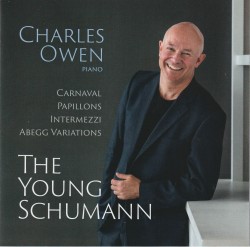 Schumann: Carnaval and Kinderszenen
Schumann: Carnaval and Kinderszenen
Edna Stern
Orchid Classics ORC100338 (edna-stern.com/recordings)
The Young Schumann
Charles Owen
Avie Records AV2647 (avie-records.com/releases/the-young-schumann-carnaval-op-9-•-papillons-op-2-•-intermezzi-op-4-•-abegg-variations-op-1)
The evergreen Carnaval is the main work on two new recordings of music for solo piano by Robert Schumann. There is an exciting sense of youthful impetuousness in Edna Stern’s recording, with fast movements taken very quickly and slower movements treated flexibly, with a generous use of rubato throughout. The quirkiness of Schumann’s language is brought to the fore as Stern emphasizes Schumann’s many sudden accents and contrasts of dynamics. Listen to the sense of improvisation in the Valse noble and the breathtaking abandon Stern brings to the infamously difficult Paganini. The final pages of the closing March are truly thrilling. This is high-octane playing, capturing a sense of live performance on the wing in a warmly recorded acoustic.
 In comparison, Charles Owen’s performance prizes sensitivity of phrasing and clarity of texture over sheer visceral excitement. Accents and inner voices are less prominent, and tempos are less extreme. This is a carefully considered performance, though this serious-mindedness doesn’t always translate into the same thrill of excitement that Stern produces. Owen fills out his album with Schumann’s first two published works, the Abegg Variations, Op.1 and Papillons, Op.2. I find Papillons, in particular, a much fresher performance, with light textures and dancing rhythms that emphasize this music’s roots in the ballroom. Owen also includes the rarely heard Intermezzi, Op.4, in a committed performance that makes one wish these six pieces were heard more often. The confident swagger of the first piece, the syncopated playfulness of the second, and the varied moods of the fifth are all vintage Schumann. The clarity of the recorded sound complements Owen’s overall textural precision and beauty of tone.
In comparison, Charles Owen’s performance prizes sensitivity of phrasing and clarity of texture over sheer visceral excitement. Accents and inner voices are less prominent, and tempos are less extreme. This is a carefully considered performance, though this serious-mindedness doesn’t always translate into the same thrill of excitement that Stern produces. Owen fills out his album with Schumann’s first two published works, the Abegg Variations, Op.1 and Papillons, Op.2. I find Papillons, in particular, a much fresher performance, with light textures and dancing rhythms that emphasize this music’s roots in the ballroom. Owen also includes the rarely heard Intermezzi, Op.4, in a committed performance that makes one wish these six pieces were heard more often. The confident swagger of the first piece, the syncopated playfulness of the second, and the varied moods of the fifth are all vintage Schumann. The clarity of the recorded sound complements Owen’s overall textural precision and beauty of tone.
Stern’s coupling is the popular and often-recorded Kinderszenen, Op.15. These “Scenes from Childhood” can sound overly precious in the wrong hands, but Stern manages an appealing freshness and innocent charm. There is originality too, in Stern’s own composition which ends her recording. The title, To-nal or not-to-nal, refers to the pull in contemporary writing between tonal and atonal harmonies. In five short sections inspired by literary quotations (Schumann, too, took much inspiration from the literature of his time), Stern’s work is a constantly shifting kaleidoscope of textures and colours.
Lovers of Schumann’s piano music will enjoy the contrasting approaches Stern and Owen bring to these inspired works.



